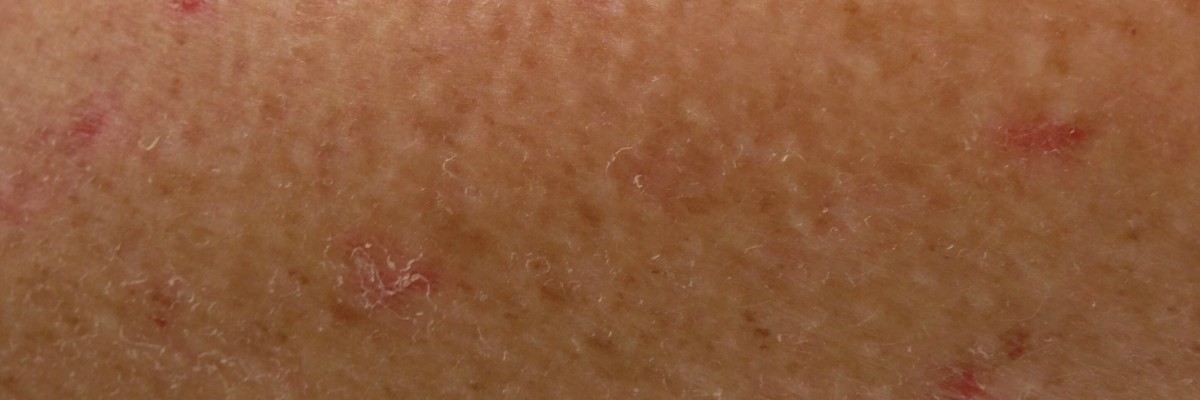Disseminated superficial actinic porokeratosis (DSAP) is a non contagious skin condition causing small red circular ‘spots’ mainly on the arms and legs.
DSAP is usually inherited, which means about half of the children of an affected parent will also have DSAP. But, a certain amount of accumulated sun exposure and possibly other factors such as immune suppression are needed to bring out this condition.
These small irregular circles vary in color from skin tone, to red or purple. Generally in the morning the spots are not as noticeable but as the day progresses and blood circulates, the spots become red (after hot showers and exercise) or purple (if it’s cold). They are usually rough and scaly.
The lesions are characterized by an irregularly-shaped thread-like ring that define the shape of the spot. In other words, the outer-edge of the spot is slightly raised.
DSAP mainly affects the arms and legs, but can also be present on hands, feet, face, shoulders and back. DSAP almost never occurs on the scalp, palms or soles.
For those with sun damaged skin (typically people living in warmer areas), spots usually begin to appear as early as 20 years old and increase in number and visibility over time. For those without too much sun damage, the condition may not present itself until middle age or even into their 60s.
Development of skin cancer within a DSAP lesion is very uncommon. However, some patients with DSAP have had significant exposure to the sun and may also have actinic keratoses and other forms of skin cancer
There is no known cure for DSAP. At present there are only treatments both medical and cosmetic. None of them work for everyone and even the effectiveness can vary on the same person depending on area of the body being treated. Also, even if you are able to get rid of some spots, typically within a year or so they come back.
Noteworthy
- DSAP is more common in women than men (though no known hormonal link has been found)
- DSAP is most common among those of white European ancestry
- Sweating is absent within the DSAP spots.
- A research team has found strong genetic evidence of a link between mutations of the mevalonate kinase gene (MVK) and disseminated superficial actinic porokeratosis (DSAP). Learn more here: http://www.sciencedaily.com/releases/2012/09/120916160931.htm
- DSAP is classified as a ‘rare disease’ by the Office of Rare Diseases (ORD) of the National Institute of Health (NIH). This means that DSAP, or a subtype of DSAP, affects less than 200,000 people in the US population.
We are conducting a medical research study to gather information about the disease. It takes about 5 minutes and your participation leads us closer to a cure. To participate click here.
[grwebform url=”http://app.getresponse.com/view_webform.js?wid=4602701&u=VqSj” css=”on”/]


My Mother has DSAP, and her spots are more individual on her arms and calves, shins. My spots are more of a rash on my calves and shins that gets red with sunlight, etc. I first noticed them when I went to Israel in Nov. 2009. They seemed to disappear for years, but have been back for about 3 months. I would like to send pictures of my Mom’s and my legs if I can figure out how to do it to see if this is the same DSAP.
Yvonne, you can post pictures directly to the post, just underneath the text box it says choose file, to upload your phoyo
Hello, my dad is dealing with DSAP at the age of 74. His are quite severe and red, and on his arms, legs and chest.
I am now very distressed because I realize I am starting to get the spots too, though they a much fewer in number and more skin colored. I’m only 33! I have an appointment with a skin doc tomorrow, but am very upset because I don’t want this condition to get worse!
Do you know if it’s possible to live with only a few of these spots here and there, or if it always escalated with age?
I did get a lot of sun and use tanning beds as a teen , but I didn’t tan all year round or anything extreme. I haven’t had any hard core sun exposure since about my mid 20’s.
Thank you!
Hello- if it provides any comfort. I first had an eruption of DSAP when I was 26 or so…dozens on my arms and legs, chest, even a few on my upper back. I’m now 42 and they really haven’t got any worse (and really after the explosion didn’t grow in numbers either, and I’m pretty sure some have disappeared too). They are mostly clear rings too so no one notices them. I was so panicked for the first 5-10 years but it really hasn’t gotten bad. Obviously, people have different experiences though, maybe some have a more mild type. Also, I don’t avoid the sun either, we have a boat and I love tropical places…I am religious about sunscreen though but I live my life. I used to be on DSAP chat boards etc all the time, I rarely even think about it now…just happen to stumble on this today. Best to you!